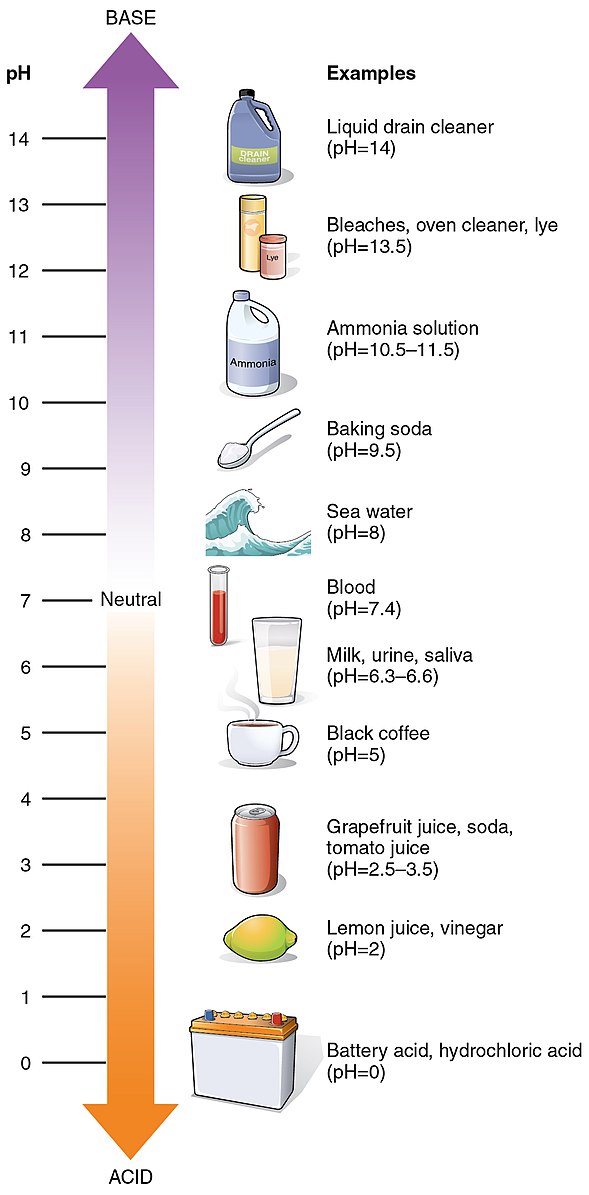The pH of dissolved water is a crucial factor that determines the overall quality and suitability of water for various applications, from drinking and irrigation to industrial processes. This comprehensive guide will delve into the intricacies of water pH, its measurement, and the factors that influence it, providing you with the knowledge to better understand and manage the pH of your dissolved water.
Understanding the pH Scale
The pH scale is a measure of the acidity or basicity (alkalinity) of a solution, ranging from 0 to 14, with 7 being the neutral point. Values below 7 indicate an acidic solution, while values above 7 indicate a basic or alkaline solution.
- Acidic water has a pH value less than 7, with 0 being the most acidic.
- Neutral water has a pH value of 7.
- Basic or alkaline water has a pH value greater than 7, with 14 being the most basic.
Factors Influencing the pH of Dissolved Water
 Image source: OpenStax College
Image source: OpenStax College
The pH of dissolved water can be affected by various factors, including the presence of dissolved solids, the surrounding environment, and human activities. Understanding these factors is crucial for maintaining the optimal pH level for your specific needs.
Dissolved Solids
The presence of dissolved solids, such as minerals and salts, can significantly impact the pH of water. For example, the dissolution of carbon dioxide (CO2) in water can lower the pH, making the water more acidic. Conversely, the presence of bicarbonate and carbonate ions can increase the pH, making the water more alkaline.
Environmental Factors
The surrounding environment can also influence the pH of dissolved water. In areas with high levels of acid runoff, such as near mining operations, the water’s pH can be significantly lowered, potentially harming aquatic life. Conversely, in regions with naturally occurring alkaline soils, the water may have a higher pH.
Human Activities
Human activities, such as the use of fertilizers, industrial processes, and wastewater discharge, can also affect the pH of dissolved water. These activities can introduce various chemicals and compounds that can alter the water’s pH, either increasing or decreasing it.
Measuring the pH of Dissolved Water
Measuring the pH of dissolved water is a straightforward process that can be done using a pH meter or test strips. These tools provide a reliable and accurate way to determine the acidity or alkalinity of the water.
pH Meters
pH meters are electronic devices that measure the hydrogen ion concentration in a solution, providing a direct reading of the pH value. These meters are widely used in various applications, from water treatment to laboratory analysis.
pH Test Strips
pH test strips are a simple and convenient way to measure the pH of dissolved water. These strips are dipped into the water, and the resulting color change is compared to a provided scale, indicating the pH value.
Maintaining the Optimal pH of Dissolved Water
Depending on the intended use of the water, the optimal pH range may vary. For drinking water, the recommended pH range is typically between 6.5 and 8.5. However, for other applications, such as irrigation or industrial processes, the optimal pH may differ.
To maintain the optimal pH of dissolved water, various treatment methods can be employed, such as:
- Neutralization: Adding a basic or acidic solution to the water to adjust the pH to the desired level.
- Aeration: Exposing the water to air, which can help remove dissolved carbon dioxide and increase the pH.
- Ion Exchange: Using ion exchange resins to remove or replace specific ions that affect the water’s pH.
- Reverse Osmosis: Removing dissolved solids and minerals that can influence the water’s pH.
By understanding the factors that affect the pH of dissolved water and implementing appropriate treatment methods, you can ensure that the water you use is within the optimal range for your specific needs.
Conclusion
The pH of dissolved water is a critical parameter that must be carefully monitored and managed to ensure the water’s suitability for various applications. By understanding the pH scale, the factors that influence water pH, and the methods for measuring and maintaining the optimal pH, you can take proactive steps to ensure the quality and safety of your dissolved water.
References:
- Fondriest Environmental, Inc. (n.d.). pH of Water. Fondriest Environmental Learning Center. https://www.fondriest.com/environmental-measurements/parameters/water-quality/ph/
- Know Your H2O. (n.d.). The pH of Water. Know Your H2O. https://www.knowyourh2o.com/indoor-4/the-ph-of-water
- U.S. Geological Survey. (n.d.). pH and Water. USGS Water Science School. https://www.usgs.gov/special-topics/water-science-school/science/ph-and-water
